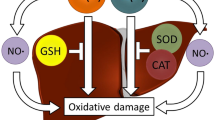Abstract
Iron overload is one of the most common iron-related toxicities, and liver is the major organ that is injured. Although oxidative stress is well accepted in the pathological mechanism of iron overload, nitrative modification in liver and the role of iron are relatively unknown. In this work, the nitrative and oxidative stress in liver was investigated in an iron-overload rat model. It was found that after 15 weeks of iron dextran administration, consistent with the increase of iron content in rat liver, both protein tyrosine nitration and protein oxidation were clearly elevated. By means of immunoprecipitation analysis, it was found that enolase nitration and oxidation status were significantly increased in iron-overload liver, whereas both α-enolase expression and activity were clearly decreased. The effects of different forms of iron on NaNO2–H2O2- and peroxynitrite (ONOO−)-dependent enolase nitration and oxidation were further investigated in vitro to elucidate the possible role of iron in enolase dysfunction in vivo. Compared with EDTA–Fe(III), ferric citrate, and ferritin, heme (hemin and hemoglobin) showed higher efficiency in catalyzing protein nitration in both models. Besides the major contribution of free iron (Fe2+ and Fe3+) to catalyze protein oxidation, Fe2+ also directly acted as a competitive inhibitor and produced a significant decrease in enzyme activity. These results suggest that the existence of various forms of iron is an important contributing factor to the elevated nitrative/oxidative modifications and diminished activity of α-enolase in the development and progress of iron-overload-associated syndromes.









Similar content being viewed by others
References
Finch C (1994) Blood 84:1697–1702
Wijayanti N, Katz N, Immenschuh S (2004) Curr Med Chem 11:981–986
Papanikolaou G, Pantopoulos K (2005) Toxicol Appl Pharmacol 202:199–211
Galaris D, Pantopoulos K (2008) Crit Rev Clin Lab Sci 45:1–23
Welch KD, Davis TZ, Van Eden ME, Aust SD (2002) Free Radic Biol Med 32:577–583
Kohgo Y, Ikuta K, Ohtake T, Torimoto Y, Kato J (2008) Int J Hematol 88:7–15
Swanson CA (2003) Alcohol 30:99–102
Pacher P, Beckman JS, Liaudet L (2007) Physiol Rev 87:315–424
Radi R (2004) Proc Natl Acad Sci USA 101:4003–4008
Peluffo G, Radi R (2007) Cardiovasc Res 75:291–302
Dalle-Donne I, Rossi R, Giustarini D, Milzani A, Colombo R (2003) Clin Chim Acta 329:23–38
Sultana R, Poon HF, Cai J, Pierce WM, Merchant M, Klein JB, Markesbery WR, Butterfield DA (2006) Neurobiol Dis 22:76–87
Sultana R, Boyd-Kimball D, Poon HF, Cai J, Pierce WM, Klein JB, Merchant M, Markesbery WR, Butterfield DA (2006) Neurobiol Aging 27:1564–1576
Lu N, Zhang Y, Li H, Gao Z (2010) Free Radic Biol Med 48:873–881
Pancholi V (2001) Cell Mol Life Sci 58:902–920
Olas B, Saluk-Juszczak J, Nowak P, Glowacki R, Bald E, Wachowicz B (2007) Nutrition 23:164–171
Bradford MM (1976) Anal Biochem 72:248–254
Agarwal S, Kulshreshtha P, Bambah Mukku D, Bhatnagar R (2008) Biochim Biophys Acta 1784:986–994
Zhao Yu, Li H, Gao Z, Xu H (2005) Eur J Pharmacol 509:195–200
Tam TF, Leung-Toung R, Li W, Wang Y, Karimian K, Spino M (2003) Curr Med Chem 10:983–995
Kalinowski DS, Richardson DR (2005) Pharmacol Rev 57:547–583
Lu N, Zhou G, Pei D, Yi L, Gao Z (2009) Toxicol In Vitro 23:1227–1233
Bartesaghi S, Trujillo M, Denicola A, Folkes L, Wardman P, Radi R (2004) Free Radic Biol Med 36:471–483
Comporti M, Signorini C, Buonocore G, Ciccoli L (2002) Free Radic Biol Med 32:568–576
Brewer JM (1985) FEBS Lett 182:8–14
Lee ME, Nowak T (1992) Biochemistry 31:2172–2180
Templeton DM, Liu Y (2003) Biochim Biophys Acta 1619:113–124
Petrak J, Myslivcova D, Man P, Cmejla R, Cmejlova J, Vyoral D (2006) Am J Physiol Gastrointest Liver Physiol 290:G1059–G1066
Tosco A, Siciliano RA, Cacace G, Mazzeo MF, Capone R, Malorni A, Leone A, Marzullo L (2005) J Proteome Res 4:1781–1788
Chen HJ, Chang CM, Lin WP, Cheng DL, Leong MI (2008) Chembiochem 9:312–323
Nagababu E, Rifkind JM (2000) Biochemistry 39:12503–12511
Romero N, Radi R, Linares E, Augusto O, Detweiler CD, Mason RP, Denicola A (2003) J Biol Chem 278:44049–44057
Mehl M, Daiber A, Herold S, Shoun H, Ullrich V (1999) Nitric Oxide 3:142–152
Mahammed A, Gross Z (2006) Angew Chem Int Ed 45:6544–6547
Beckman JS, Ischiropoulos H, Zhu L, van der Woerd M, Smith C, Chen J, Harrison J, Martin JC, Tsai M (1992) Arch Biochem Biophys 298:438–445
Détivaud L, Nemeth E, Boudjema K, Turlin B, Troadec MB, Leroyer P, Ropert M, Jacquelinet S, Courselaud B, Ganz T, Brissot P, Loréal O (2005) Blood 106:746–748
Acknowledgments
This work was supported by grants from the National Natural Science Foundation of China (Nos. 30300073 and 30670481), the Program for New Century Excellent Talents in University (No. NCET-05-0649), and the Fundamental Research Funds for the Central Universities (HUST No. 2010ZD010).
Author information
Authors and Affiliations
Corresponding author
Rights and permissions
About this article
Cite this article
Lu, N., Li, X., Li, J. et al. Nitrative and oxidative modifications of enolase are associated with iron in iron-overload rats and in vitro. J Biol Inorg Chem 16, 481–490 (2011). https://doi.org/10.1007/s00775-010-0747-6
Received:
Accepted:
Published:
Issue Date:
DOI: https://doi.org/10.1007/s00775-010-0747-6




